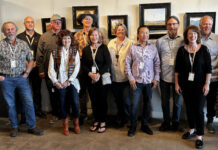
Many artists will tone a canvas before tackling subject matter. Few paint it black. Brian Buckrell explains why working on a black canvas has its advantages.

“At the Top,” by Brian Buckrell, 2012, oil, 8 x 10 in. The panel was toned with black and some dioxazine purple.
“One of the problems I had in learning to paint is the tendency to overdo things and move too far into representational painting,” says the artist from Vancouver, Canada. “This forces me to simplify. When you are working on black, you are already far away from what you are looking at.”

Brian Buckrell
Only about 20 percent of Buckrell’s plein air pieces start on panels toned black; the rest are toned with a dark red. The artist paints on MDF board or Masonite, and applies black gesso or red acrylic paint with a foam roller to give the surface some tooth. When working on black, he sometimes decides to put a bit of transparent color on part of the canvas, usually dioxazine purple, violet, or green, “just to give a bit of a direction of color to it,” he says. “It doesn’t take it away from a deep dark black, it just gives a tone to it.” Buckrell draws in the composition with a graphite pencil, which shows up well on the black paint. He paints thinly at first, favoring transparent pigments, and suggesting the midtones and highlights. “Lay them in alone and you have just targeted what you want, with the black serving to emphasize that,” Buckrell advises. Then he moves on to opaque lights on top. He works in either acrylic or oil paint, favoring acrylic for most pieces.

Buckrell started this piece by drawing the composition with a yellow china marker on a panel toned with black gesso.

Buckrell’s piece in the “spots of color” phase of painting

The finished 6″ x 6″ sketch
“For me, working on a dark canvas, it’s a spot-the-color exercise,” says Buckrell. “It’s about putting in a spot of color and putting another color next to it, trying to suggest a pattern that you want the viewer to see. For some reason or another, working on a dark value is more like sculpting. The forms emerge out of it. There’s a feel that I get that I don’t get from a light value tone.”

“Estuary Evening,” by Brian Buckrell, 2012, oil, 6 x 8 in. Done with a palette knife.

An acrylic piece in progress, painted over black gesso toned with dioxazine purple.
This approach certainly favors scenes that have a lot of dark areas in them. But even with well-lit scenes, a bit of black outlining elements or peeping through between objects creates an interesting sensation of depth. “The amount of black that is remaining at the end is sometimes a large part of the piece and sometimes a small part, as with any painting,” says Buckrell. “It’s a bit of an unknown at the start.”

“Left to Rot,” by Brian Buckrell, 2011, oil, 6 x 8 in.
Buckrell pauses and then speaks candidly. “It’s a serendipitous crapshoot, and you hope that it turns out all right.”




